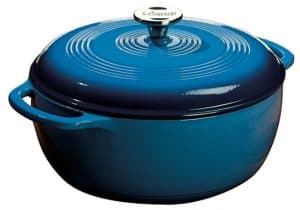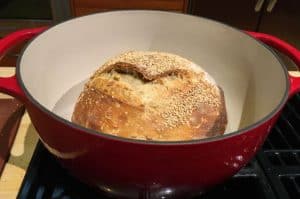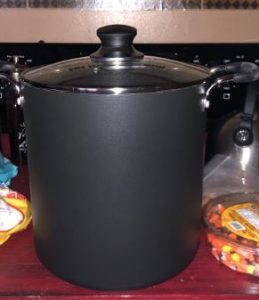When you’re looking to buy a new pot for your kitchen, the options can be overwhelming. Do you need a stock pot or a Dutch oven? What’s the difference and which one is right for you? In this article, we’ll break down the difference between stock pot and dutch oven and help you decide which one is best for your needs.
So read on to learn more!
What is a Stock Pot vs a Dutch Oven?
A stock pot is a large, heavy pot that is typically used to make soups and stews. It has a wide base and tall sides, which allows for evaporation and the release of flavors.
A Dutch oven, on the other hand, is a thick-walled pot that can be used for both cooking and baking. It has a tight-fitting lid, which helps lock in flavors and moisture.
Both pots are made from either metal or ceramic, and they can be used on the stovetop or in the oven.
Why Is It Important to Know the Difference?
Knowing the difference between a stock pot and a Dutch oven is important because each pot is better suited for different tasks.
For example, a stock pot is ideal for making soup or stew because the tall sides help prevent evaporation. The wide base also allows for more surface area, which means that the flavors can be more concentrated.
A Dutch oven, on the other hand, is better for braising or baking because of its thick walls and a tight-fitting lid. The thick walls help retain heat, while the lid helps lock in moisture.
So, if you’re looking for a pot to make soup, a stock pot is your best bet. However, if you’re looking for a pot to braise meat or bake a casserole, a Dutch oven is the way to go.
Let’s Talk About Dutch Ovens
The History of a Dutch Oven
 A Dutch oven is a type of pot that has been used for cooking for centuries. The pot is made of cast iron and is shaped like a bowl with a lid.
A Dutch oven is a type of pot that has been used for cooking for centuries. The pot is made of cast iron and is shaped like a bowl with a lid.
The origins of the Dutch oven date back to the 17th century when English craftsman Abraham Darby started using cast iron to compete with the expensive copper and brass cookware of that time.
Dutch ovens became popular in the United States during the 18th and 19th centuries when they were used by settlers and frontiersmen. The pots were perfect for cooking over an open fire, and they could be used to make everything from stews to bread.
Dutch ovens are still popular today, and they are often used by campers, hikers, and other outdoor enthusiasts.
What Exactly is a Dutch Oven?
A Dutch oven is a type of pot that has a tight-fitting lid. It is usually made of cast iron and is often used for cooking stews and soups. Dutch ovens can also be used for baking bread and other desserts.
Dutch ovens are popular because they are versatile and durable. They can be used on the stovetop or in the oven. They also have a long lifespan and can be used for many different types of dishes.
Who Should Use Dutch Ovens?
Dutch ovens are an excellent option for anyone who wants to cook outdoors, especially campers and hikers. They are also a good choice for anyone who wants to cook food evenly, whether on the stovetop or in the oven.
What Can You Cook in a Dutch Oven?
 A Dutch oven can be used for a variety of cooking options, from soups and stews to roasts and casseroles. The key to success with any Dutch oven dish is to get the oven hot before adding the food. This will help ensure that your food cooks evenly and doesn’t stick to the pot.
A Dutch oven can be used for a variety of cooking options, from soups and stews to roasts and casseroles. The key to success with any Dutch oven dish is to get the oven hot before adding the food. This will help ensure that your food cooks evenly and doesn’t stick to the pot.
One popular option is to make a simple soup or stew. Start by heating some oil in the Dutch oven over medium heat. Then, add some chopped onion and garlic and cook until softened. Add your desired amount of meat and cook until browned. Finally, add your broth and vegetables and simmer until cooked through.
Another great option is to roast a chicken or other piece of meat like braised short ribs in the Dutch oven. Start by browning the meat in the pot over medium heat. Then, add some chopped vegetables and enough broth or water to come up about halfway up the sides of the meat. Cover the pot and bake in a preheated oven until cooked through.
There are endless possibilities when it comes to cooking with a Dutch oven. With a little creativity, you can make just about anything in this versatile pot.
Can You Put a Dutch Oven into the Oven?
Yes, a Dutch oven can be placed in a large convection oven. This is one of the reasons why they are so popular. When placed in the oven, a Dutch oven provides even heat distribution, which is perfect for cooking stews, soups, and casseroles.
If you’re using a Dutch oven on the stovetop, it’s important to heat the pot gradually. The best way to do this is to place the pot on a burner set to low heat and gradually increase the heat until it’s at the desired temperature.
Can Dutch Ovens Go from Fridge to Stove?
Most Dutch ovens can go from the fridge to the stove. However, it’s important to check your pot’s instructions to be sure. Some manufacturers don’t recommend putting their pots in the fridge or freezer.
If you’re unsure, it’s always best to err on the side of caution and let your pot come to room temperature before placing it on the stove or into a hot oven.
Are Dutch Ovens Non-Stick?
Many people make the mistake of thinking that Dutch ovens are nonstick. However, this isn’t the case. In fact, most Dutch ovens are made of cast iron, which is known for being sticky.
The key to cooking with a Dutch oven is to properly season the pot before use. Seasoning the pot helps create a nonstick surface and also prevents rust.
Are Dutch Ovens Easy to Clean?
Dutch ovens are easy to clean if you take the time to season them properly. If your pot is properly seasoned, food will release easily, and cleanup will be a breeze.
If your pot isn’t properly seasoned, it’s important to scrub it with soap and water after each use. This will help prevent the build-up of rust and make cleanup easier.
Okay, So What About Stock Pots?
History of Stock Pots
 A stock pot is a large, deep cooking pot that is typically used to make soups and stews. The history of the stock pot is a long and varied one, with many different cultures contributing to its development.
A stock pot is a large, deep cooking pot that is typically used to make soups and stews. The history of the stock pot is a long and varied one, with many different cultures contributing to its development.
The first known stock pots were made in China over 4,000 years ago. These early stock pots were made from ceramic or stone and were used for cooking rice and other grains. The Chinese were also the first to add metal handles to their pots, which made them much easier to use.
The first stock pots in America were brought over by the British during the colonization of the country. These pots were made from iron and were used for cooking stews and soups. The British also introduced the tradition of using stock pots to make Christmas pudding.
Today, stock pots are made from a variety of materials, including aluminum, stainless steel, and ceramic. They come in a variety of sizes and shapes, making them suitable for use in any kitchen.
What is a Stock Pot Used For?
A stock pot is a large, deep cooking pot that is typically used to make soups and stews. It is made from a variety of materials, including aluminum, stainless steel, and ceramic, and comes in a variety of sizes and shapes. It is suitable for use in any kitchen.
Stock pots are used for cooking a variety of foods, including soups, stews, sauces, and pasta. They can also be used for boiling water and cooking rice. Some stock pots come with a strainer basket, which makes it easy to remove solid ingredients from the pot.
Are Stock Pots Nonstick?
Unlike Dutch ovens, stock pots come in non-stick varieties. The non-stick coating on a stock pot is specially formulated to resist sticking and scorching, making it easy to cook soups, stews, and other one-pot meals without having to stir or scrape the bottom constantly.
Most stock pots also have a tight-fitting lid that helps seal in heat and moisture, making them ideal for simmering and boiling.
Are Stock Pots Bigger than Dutch Ovens?
Are stock pots bigger than Dutch ovens? Well, that’s a difficult question to answer because there are so many different types and sizes of both stock pots and Dutch ovens. However, in general, stock pots are usually bigger than Dutch ovens.
Dutch ovens are typically cylindrical in shape, with a round or oval lid. They have a tight-fitting lid that helps create a convection oven effect, meaning the heat circulates around the food, cooking it evenly.
Stocks pots are also cylindrical, but they tend to be wider and taller than Dutch ovens. They also come with a lid, but it’s not as snug-fitting. This allows for more evaporation and is better for boiling large amounts of liquid.
Can Stock Pots Go in the Oven?
Stock pots are made from a variety of materials, including aluminum, stainless steel, copper, and enameled cast iron. Some are oven-safe, and some are not.
If you have an oven-safe stock pot, you can use it for tasks such as browning meat or sautéing vegetables before adding the rest of the ingredients and putting it on the stove to simmer. Oven-safe stock pots are also great for making one-pot meals, such as chili or pasta bakes.
The ideal temperature and cooking time will vary depending on what you’re making, so be sure to consult a recipe. In general, though, most oven-safe stock pots can be used at temperatures up to 500 degrees Fahrenheit.
How Do You Clean a Stock Pot?
Cleaning a stock pot is pretty simple, regardless of the material it’s made from.
If your pot is dishwasher-safe, you can obviously just pop it in there and let the machine do its thing. If not, washing it by hand is easy enough. Just fill the pot with warm water and dish soap and let it soak for a few minutes. Then, scrub it with a sponge or brush and rinse it clean.
For tougher stains, you can make a paste out of baking soda and water and use that to scrub the pot. You can also try soaking it in vinegar or hot water with lemon if you’re dealing with hard-to-remove stains.
No matter what material your pot is made from, it’s important to avoid using harsh chemicals or abrasive scrubbers, as these can damage the pot.
Can Stockpots Go from Fridge to Stove?
Most stockpots can go from fridge to stove with minimal wait time. When taking a pot out of the fridge though, be sure to let it warm up on the counter for a little bit before putting it on the stove. Putting a cold pot on the stove can cause the pot to crack.
Final Overview
Is a Stock Pot or a Dutch Oven Better?
There is no definitive answer to this question as both stock pots and Dutch ovens have their own advantages and disadvantages.
A good way to decide which one is better for you would be to consider what you will be using it for – if you plan on making a lot of stews or soups, a stock pot would probably be the better option as they typically have a larger capacity. On the other hand, if you want to be able to use your pot for braising or baking, a Dutch oven would be the way to go.
At the end of the day, it really comes down to personal preference – so choose the one that you think will suit your needs the best!
